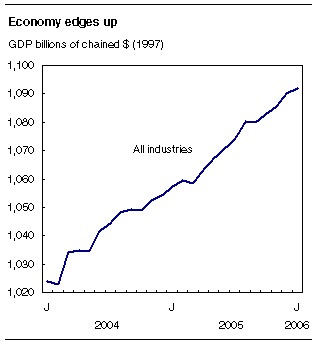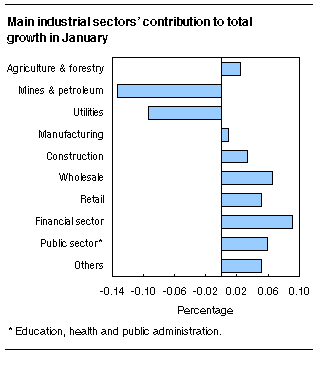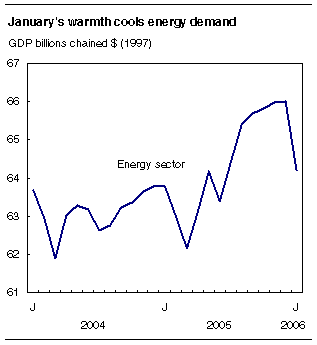
















 |
|
 |                |
Information identified as archived is provided for reference, research or recordkeeping purposes. It is not subject to the Government of Canada Web Standards and has not been altered or updated since it was archived. Please "contact us" to request a format other than those available.

|

Friday, March 31, 2006 Gross domestic product by industry
The Canadian economy edged up 0.2% in January, a pace slightly slower than that of the previous three months. Strength in service industries more than offset a decrease in the production of goods. Growth was concentrated in wholesale and retail trade, notably from vigorous sales of motor vehicles, as well as in construction activities, and in finance and real estate. Offsetting part of the gains was the marked decline in the energy sector as a result of warmer weather conditions. Despite temporary closures and reduced production at motor vehicle assembly plants, manufacturing edged up slightly. 
Strength in retailing and wholesaling of motor vehiclesThe retail trade sector grew 0.9% in January. Shoppers increased their spending at almost every type of store, with the exception of supermarkets and service stations. The largest gains were recorded in furniture, home furnishings and electronic stores, general merchandise stores (including department stores), and in building and outdoor home supplies stores. There also was notable strength in sales of new and used motor vehicles.
Wholesale trade activities grew markedly in January (+1.2%) for a second consecutive month, due to a sharp increase in wholesaling of motor vehicles. Excluding motor vehicles and parts, other significant increases were recorded for machinery and equipment, household and personal goods, and building materials. 
Warm weather cools down the demand for energyThe energy sector dropped 2.7% in January. The decline in output was driven mainly by milder weather conditions, as heating needs (measured by the number of heating degree-days) decreased 18% compared to the same period last year. Electricity generation and transmission dropped 3.8% and the distribution of natural gas declined by 7.0%. Oil and gas extraction declined 0.9%. Both crude petroleum and natural gas extraction recorded declines in January. Crude oil extraction on the East Coast was reduced by unscheduled maintenance while high inventories and decreased demand lowered extraction of natural gas. Oil and gas exploration dropped 11.5%, mostly because of supply constraints due to the reestablishment of the offshore rigs in the Gulf of Mexico. Mining activity retreated 2.4%, pulled down by a 14% decline in output of potash, as a reduction in foreign demand coincided with temporary site shutdowns. Industrial production (the output of Canada's factories, mines and utilities) retreated 0.9% in January, pulled down by strong declines in the mining, oil and gas sector and in utilities. In the United States, industrial production declined 0.3%, dragged down by utilities while manufacturing and mining advanced. 
Manufacturing edges up despite volatility in motor vehicles productionManufacturing output increased 0.1% in January. Gains were recorded in 14 of the 21 major groups accounting for 49% of this sector's output. Large declines were reported mainly by manufacturers of transportation equipment (-3.6%), fabricated metal products (-2.5%), paper products (-1.9%), and machinery (-1.0%). Recent shifts in consumer preferences have made motor vehicle manufacturing volatile. Following strong gains in October, the production of motor vehicles fell markedly in January (-5.6%), marking a third consecutive monthly decline. The output of motor vehicle parts followed a similar path, retreating by 4.8% in January, and having declined since September, with the exception of a single month of growth in December. Gains in wood products (+3.1%), chemicals (+2.1%), and non-metallic mineral products (+5.1%) contributed to limit the decline in output of the sector. Vigour in new housing constructionConstruction activity rose 0.6% in January. Residential construction gained 1.2%, marking a fifth consecutive monthly increase. Housing starts grew markedly in most urban areas except those in British Columbia. Non-residential building construction (+0.6%) and engineering, repairs and other construction activities (+0.2%) also recorded gains. All types of non-residential buildings (commercial, industrial and institutional) grew. Buoyant financial and real estate sectorActivity in the financial and real estate sectors picked up some speed in January (+0.5%). An increase in the volume of transactions on Canadian stock exchanges as well as strong sales of mutual funds pushed up the output of the finance and insurance sector by 0.6%. In addition, sales of existing homes increased markedly in major metropolitan areas, particularly in Calgary and Edmonton, helping real estate agents and brokers to raise their output 3.2%. Available on CANSIM: tables 379-0017 to 379-0022. Definitions, data sources and methods: survey number 1301. The January 2006 issue of Gross Domestic Product by Industry, Vol. 20, no. 1 (15-001-XIE, $12/$118) is now available. Data on gross domestic product by industry for February will be released on April 28. For general information or to order data, contact Yolande Chantigny (1-800-887-IMAD; imad@statcan.gc.ca). To enquire about the concepts, methods or data quality of this release, contact Bernard Lefrançois (613-951-3622), Industry Accounts Division.
| |||||||||||||||||||||||||||||||||||||||||||||||||||||||||||||||||||||||||||||||||||||||||||||||||||||||||||||||||||||||||||||||||||||||||||||||||||||||||||||||||||||||||||||||||||||||||||||||||||||||||||||||||||||||||||||||||||||||||||||||||||||||||||||||||||||||||||||||||||||||||||||||||||||||||||||||||||||||||||
|
|
|